Keeping a Saltwater Fish Tank
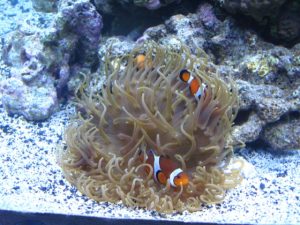 The Place to Acquire Saltwater Fish
The Place to Acquire Saltwater FishA saltwater fish store is unique in the fact that it is the perfect place to acquire a new addition to an individual’s collection of aquarium dwellers. Saltwater fish are notorious for being difficult to raise and provide a natural environment suitable for long term survival. This statement could be nothing as far from the truth. That used to be a true statement twenty years ago. Science and technology have perfected the art of saltwater fish keeping. At a saltwater aquarium store this difficult concept soon is dispelled. Saltwater Aquarium keepers are a breed that has the skills and knowledge of what it takes to keep these beautiful, colorful animals alive and thriving. There are such a multiple of choices for the avid saltwater enthusiast to indulge their interests and collection of species.
Types of Aquariums and the species kept
Maybe a saltwater collection is presented in a office location as a center piece of conversation. The aquarium could be made to look like a living reef, with the addition of live coral, sea sponges, fish, and a little live rock the allusion of the bottom of the oceans reefs can be a reality in the office. Watching these types of aquarium set-ups is very relaxing and very educational as well. Professionals at the saltwater fish store will be able to educate and inform the aquarium keeper how to keep their fish, corals, live rock, and any other type of invertebrate alive and thriving. Usually these individuals at the saltwater fish store are extremely educated from years of learning the craft of fish keeping. Water, temperature, food, species of fish all plays important roles in keeping an aquarium in a state of homoeostasis.
Difficulty of Species
Very exotic species can be purchased from the saltwater aquarium store. Most species are captured in the wild and begin their life in the wild. Usually the aquarium store has importers that specialize in different locations and different breeds. A type of fish that is viewed in a catalogue or another aquarium can usually be acquired if the name of the species is known. A reputable saltwater aquarium store will have the species stay in a isolation tank called quarantine. Quarantine is very important so that if the new fish, coral, animal has any parasites, diseases or other dangerous infectious problems it will not spread the problem. Another reason for quarantine is to get the animal accustomed to captivity and eating. Often new fish captured will not eat and often the water PH and other factors like salt content must be gradually introduced to be tolerated by the animal.

 The Banded Trochus Snail is touted by aquarists of all experience levels for numerous reasons. Like other members of the Trochidae family, the Banded Trochus is easy to care for and very adept at working as your aquarium’s cleanup crew. The Banded Trochus Snail normally has a black foot that is an off white/tan color on the underside of the foot. It boasts a pale gray, top- or pyramid-shaped shell. Thanks to the maroon stripes or bands on its shell, the Banded Trochus Snail adds a unique flair to any marine system.
The Banded Trochus Snail is touted by aquarists of all experience levels for numerous reasons. Like other members of the Trochidae family, the Banded Trochus is easy to care for and very adept at working as your aquarium’s cleanup crew. The Banded Trochus Snail normally has a black foot that is an off white/tan color on the underside of the foot. It boasts a pale gray, top- or pyramid-shaped shell. Thanks to the maroon stripes or bands on its shell, the Banded Trochus Snail adds a unique flair to any marine system.
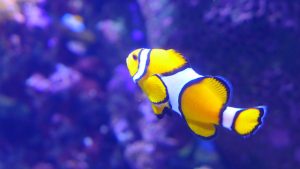 Easily the most recognizable and popular saltwater fish in the hobby is the clownfish (or anemonefish). They are prized not only for their beauty and hardiness but also for their interesting symbiotic lifestyle with host anemones.
Easily the most recognizable and popular saltwater fish in the hobby is the clownfish (or anemonefish). They are prized not only for their beauty and hardiness but also for their interesting symbiotic lifestyle with host anemones.
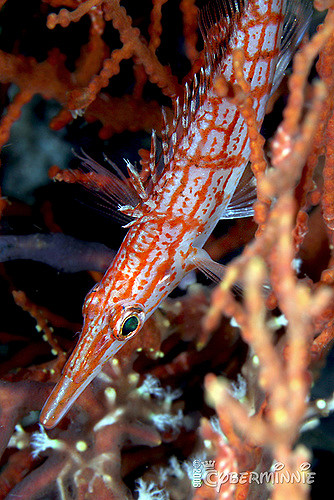 This Hawkfish, or going by its scientific name of cirrhitops fasciatus, has a bright red body with bluish-white freckles on the face and light vertical stripes along the body. Although most Hawkfish grow large, a few Hawkfish species, such as the Hawaiian Banded Hawkfish, remain fairly petite, which makes them suitable for smaller aquariums. The largest size these beautiful fish usually become is about 5 inches.
This Hawkfish, or going by its scientific name of cirrhitops fasciatus, has a bright red body with bluish-white freckles on the face and light vertical stripes along the body. Although most Hawkfish grow large, a few Hawkfish species, such as the Hawaiian Banded Hawkfish, remain fairly petite, which makes them suitable for smaller aquariums. The largest size these beautiful fish usually become is about 5 inches. Since the development of Instant Ocean sea salt in 1964, it has grown to become the standard synthetic sea salt formula, used by more aquariums both large and small around the world. Its beginnings stem from a desire to provide a viable alternative to natural seawater — one that not only kept organisms alive, but also enabled them to reproduce and thrive.
Since the development of Instant Ocean sea salt in 1964, it has grown to become the standard synthetic sea salt formula, used by more aquariums both large and small around the world. Its beginnings stem from a desire to provide a viable alternative to natural seawater — one that not only kept organisms alive, but also enabled them to reproduce and thrive.
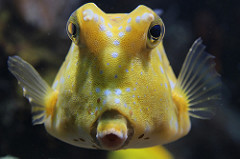 2. Saltwater angels 35% off!
2. Saltwater angels 35% off!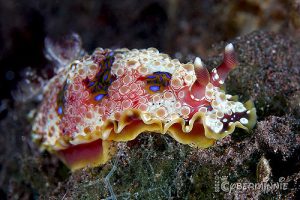 This week’s “Tip of the Week” comes from a question I received from a customer with a Zoanthid-eating Nudibranch problem.
This week’s “Tip of the Week” comes from a question I received from a customer with a Zoanthid-eating Nudibranch problem.